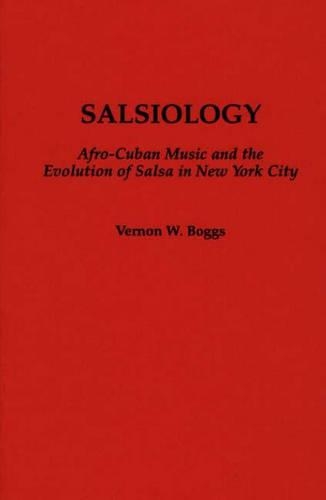
Salsiology: Afro-Cuban Music and the Evolution of Salsa in New York City
(Hardback)
Publishing Details
Salsiology: Afro-Cuban Music and the Evolution of Salsa in New York City
By (Author) Vernon W. Boggs
Bloomsbury Publishing PLC
Praeger Publishers Inc
23rd March 1992
United States
Classifications
Tertiary Education
Non Fiction
781.62969729107471
Physical Properties
Hardback
400
Width 156mm, Height 235mm
794g
Description
Boggs presents a history of Salsa, showing how Afro-Cuban music was embraced in New York City, how it has undergone cycles of popularity, and how it has been replicated abroad. Extensively illustrated with photographs of the bands and clubs as well as the key leaders and promoters, a night at the Palladium, the Cheetah, or the Park Palace comes alive. In addition, Boggs provides interviews with such key figures as Palladium Mambero Ernie Ensley and Izzy "Mr. Salsa" Sanabria. From its roots in Cuba through present-day Salsa clubs, Boggs provides a tour of a popular music form that has had a significant impact in the Latin community as well as among contemporary pop and serious composers. This book should be useful in the fields of musicology, black studies, American culture, sociology anthropology, and for students of contemporary Latin-American culture.
Reviews
"Fascinating! The people who play and present New York Latin music come alive in their own words. Bomba y plena, rumba, mambo, bugalu--it's all here in plain English. If you don't know anything about the music, this book gives you a way in. If you do know Latin music, it's a must."- Ned Sublette NPR Radio
"I'm sure that there are other mamberos like me out there who will agree that Salsiology is pure straight ahead mambo!"- John A. Lucchese author of Pachanga
"It was about time for a comprehensive book written at the epicenter of salsa, and Boggs' Salsiology covers it all."- Cristobal Diaz Cuban musicologist Fondacion Musicalia, Puerto Rico
"Salsiology. . . goes right to the heart of how salsa affected dancers, its connection with the Boogaloo, the role of the Palladium in spreading it, and its birthplace, New York City. This is a book for anyone seeking the truth behind the salsa label. . . ."-Nelson Rodriguez Columnist for New York Latino, La Nacion, El Especial and Latin Beat
. . . . A collection of essays and interviews by various writers, all compiled by Vernon Boggs, a salsa scholar and fan, the book traces the development of salsa with a bias toward making it clear that the music developed in the United States. Mr Boggs interviews everybody from a salsa booking agent, Ralph Marcado, to the pianist and composer Johnny Colon; there are chapters called Back to Africa: The Reverse' Transculturation of Salsa/Cuban Popular Music, ' and chapters on how to play salsa. The major focus of the book is to point out how salsa came about, ' said Mr. Boggs. There is so much interpretation about it, and I wanted to lay it to rest, to explain how the music came from New York. The lyrics of the music are in Spanish and unfortunately for Americans, when you speak any other language, then it's foreign; xenophobia exists. Salsa is American music, from New York. it's like a house: you can see it has a foreign foundation, from Cuba, but its structure is New York. It's as American as apple pie.-New York Times
This book is an excellent resource for a history of Afro-Hispanic music in New York City, the Caribbean, and Latin America. It provides a number of examples of how cultural forms are created and disseminated across national, ethnic, racial, and class boundaries. Sociologists interested in the study of popular music should find this book useful and enjoyable to read.-American Journal of Sociology
"This book is an excellent resource for a history of Afro-Hispanic music in New York City, the Caribbean, and Latin America. It provides a number of examples of how cultural forms are created and disseminated across national, ethnic, racial, and class boundaries. Sociologists interested in the study of popular music should find this book useful and enjoyable to read."-American Journal of Sociology
." . . . A collection of essays and interviews by various writers, all compiled by Vernon Boggs, a salsa scholar and fan, the book traces the development of salsa with a bias toward making it clear that the music developed in the United States. Mr Boggs interviews everybody from a salsa booking agent, Ralph Marcado, to the pianist and composer Johnny Colon; there are chapters called Back to Africa: The Reverse' Transculturation of Salsa/Cuban Popular Music, ' and chapters on how to play salsa. The major focus of the book is to point out how salsa came about, ' said Mr. Boggs. There is so much interpretation about it, and I wanted to lay it to rest, to explain how the music came from New York. The lyrics of the music are in Spanish and unfortunately for Americans, when you speak any other language, then it's foreign; xenophobia exists. Salsa is American music, from New York. it's like a house: you can see it has a foreign foundation, from Cuba, but its structure is New York. It's as American as apple pie."-New York Times
Author Bio
VERNON W. BOGGS is Assistant Professor of Sociology at York College and the Graduate Center, CUNY. He co-edited with Gerald Handel and Sylvia Fava The Apple Sliced: Sociological Studies of New York City (Praeger, 1983). His articles on music and New York life have appeared in such journals as Latin Beat, the Journal of Popular Music and Society, and Social Policy.
